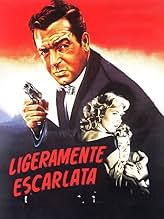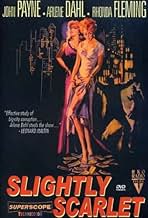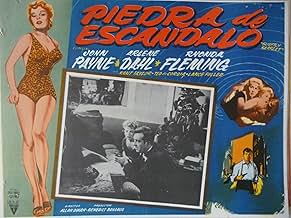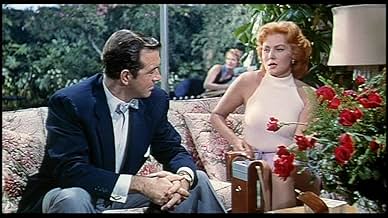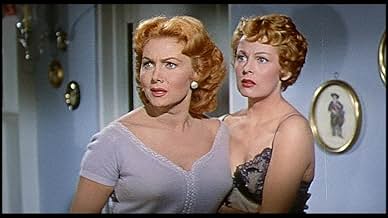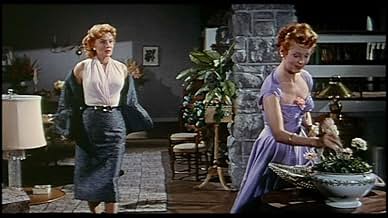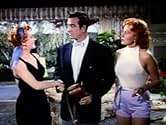NOTE IMDb
6,5/10
1,4 k
MA NOTE
Un affairiste urbain s'implique dans le crime organisé, la vie politique locale et corrompue et la greffe tout en tombant amoureux de la fiancée du maire nouvellement élu.Un affairiste urbain s'implique dans le crime organisé, la vie politique locale et corrompue et la greffe tout en tombant amoureux de la fiancée du maire nouvellement élu.Un affairiste urbain s'implique dans le crime organisé, la vie politique locale et corrompue et la greffe tout en tombant amoureux de la fiancée du maire nouvellement élu.
- Réalisation
- Scénario
- Casting principal
Fred Aldrich
- Policeman
- (non crédité)
Murray Alper
- Hood
- (non crédité)
Albert Cavens
- Man at Campaign Headquarters
- (non crédité)
Ellen Corby
- Martha
- (non crédité)
Paul Cristo
- Man at Campaign Headquarters
- (non crédité)
Sam Flint
- Man at Campaign Headquarters
- (non crédité)
Curt Furberg
- Man at Campaign Headquarters
- (non crédité)
Rudy Germane
- Hood
- (non crédité)
Frank Gerstle
- Dave Dietz
- (non crédité)
Kenneth Gibson
- Man at Campaign Headquarters
- (non crédité)
Roy Gordon
- General Norman B. Marlowe
- (non crédité)
Avis à la une
Big-city chronicle dealing with mobsters , corruption , prohibited loves and many other things . Concerning a small-time gangster carries out an assignment from Mafia boss , Ted de Corsia, to smear a law-and-order político , Ken Taylor , running for Mayor . Then he falls in love with the candidate 's secretary , Rhonda Fleming , it leads the plot mucks up even further . Innocent Rhonda has a crook , tipsy and ex-con sister , Arlene Dahl . Later on , Payne attempts to go straight and ends up running the dark business when De Corsia escapes town. Gang leader Payne meeting his comeuppance when he tangles with Rhonda's sister , Arlene Dahl , a hazardous Kleptomaniac . Out of the shadows of a vice-ridden city comes James M Caín most explosive drama ¡ James M Caín scorchingly frank expose of the operators behind big city graft.
A spiffy , thrilling and medium budget Noir Film drama based on the James M Caín novel titled "Love's lovely counterfeit" .James M Cain wrote the prestigious "The postman always rings twice" that had several cinematic adaptations and "Slightly scarlet" script was well written by Robert Blees . Being an effective and provoking studio about mafia , corruption , political messes and thunderous love relationships . This is a smart example of Allan Dwan's 50 output , a good and fine director who made a lot of films , many of them belonging to Noir genre . Although the story results to be some confusing , as forget the twisted plot and just watch the character actors and actresses interplay .Trío protagonists give nice acting . John Payne is frankly well as a gang leader tangled with two beautiful women. Rhonda Fleming is gorgeous as the good girl falling for gang leader and his sister Arlene Dahl is wonderful . Both of whom , Fleming and Dahl , steal the show as the two dynamic sisters . Support cast is very good such as : Kent Taylor , Ted de Corsia , Buddy Baer , Lance Fuller , Ellen Corby and many others .
Colorful cinematography in Technicolor and SuperScope by John Alton , a magnificent cameraman who along with Nicolas Musuruca are the main creators in Noir photography .As well as atmospheric and evocative cinematography by Louis Forbes and uncredited Howard Jackson . The motion picture produced by Benedict Bogeaus was competently directed by Allan Dawn . Even Martin Scorsese incidentally has tipped his cap to this great filmmaker and acknowledge him as an important influence . Dwan had a prolific career directing all kinds of genres as Westerns , Noir , drama , thriller , adventure, such as : Three musketeers , Iron mask , Pearl of the South Pacific , Heidi , Enchanted Island , Escape to Burma , The Gorilla , Rebecca of Sunnybrook farm , Passion , Brewster's millions , Cattle Queen Montana , Tenesse partner , Sands of Iwo Jima , among others . Rating 7/10 . Notable and decent Noir movie .
A spiffy , thrilling and medium budget Noir Film drama based on the James M Caín novel titled "Love's lovely counterfeit" .James M Cain wrote the prestigious "The postman always rings twice" that had several cinematic adaptations and "Slightly scarlet" script was well written by Robert Blees . Being an effective and provoking studio about mafia , corruption , political messes and thunderous love relationships . This is a smart example of Allan Dwan's 50 output , a good and fine director who made a lot of films , many of them belonging to Noir genre . Although the story results to be some confusing , as forget the twisted plot and just watch the character actors and actresses interplay .Trío protagonists give nice acting . John Payne is frankly well as a gang leader tangled with two beautiful women. Rhonda Fleming is gorgeous as the good girl falling for gang leader and his sister Arlene Dahl is wonderful . Both of whom , Fleming and Dahl , steal the show as the two dynamic sisters . Support cast is very good such as : Kent Taylor , Ted de Corsia , Buddy Baer , Lance Fuller , Ellen Corby and many others .
Colorful cinematography in Technicolor and SuperScope by John Alton , a magnificent cameraman who along with Nicolas Musuruca are the main creators in Noir photography .As well as atmospheric and evocative cinematography by Louis Forbes and uncredited Howard Jackson . The motion picture produced by Benedict Bogeaus was competently directed by Allan Dawn . Even Martin Scorsese incidentally has tipped his cap to this great filmmaker and acknowledge him as an important influence . Dwan had a prolific career directing all kinds of genres as Westerns , Noir , drama , thriller , adventure, such as : Three musketeers , Iron mask , Pearl of the South Pacific , Heidi , Enchanted Island , Escape to Burma , The Gorilla , Rebecca of Sunnybrook farm , Passion , Brewster's millions , Cattle Queen Montana , Tenesse partner , Sands of Iwo Jima , among others . Rating 7/10 . Notable and decent Noir movie .
Anyone remotely interested in cinematography and art direction should see this. John Alton, chiefly famous for his work in black and white, here switches to livid colour and achieves some of the most daring and moody effects ever known in colour films. This was a decade before 'flashing' the film became popular (a technique developed by Freddie Young, who told me all about it at the time he began the trend, with Lumet's 'Deadly Affair'). Everything here is so vivid, and the games played with colour in choice of sofas, walls, carpets, not to mention hair, are so intense, that the film is really chiefly of interest for all of that. Alton had to work only with variations in lighting, not with film processing possibilities. What he did is incredibly audacious, worth watching over and over just to study it. He has whole figures in shadow, and faces often are eclipsed by darkness in a bright room. It is really an incredibly dazzling display of virtuosity and genius. The two lead gals have matching hair, which plays well on the sets. Rhonda Fleming was a notorious strawberry blonde, and although I seem to recall that Arlene Dahl was really a normal blonde and presumably had her hair died to match Fleming's for this film, here they are very like the sisters they play indeed, with matching peachy hair and bright blue eyes. It is all a symphony of light and dark and colour combinations, like a modernist painting. The story is tepid, diluted from a James Cain novel about city corruption and crime. Arlene Dahl is not very convincing as a kleptomaniac siren who is supposed to be deeply psychologically disturbed (that part only comes out at the end, though we know about the thefts from the beginning, as the film begins with her coming out of prison). Rhonda Fleming swings her hefty bust around with confidence, and glares with her blue eyes at people as she challenges them, which with her fiery nature she does a lot. Into this mix comes a very seedy character played by John Payne, who by this time was really getting a little too old for such roles, nice fellow though he was. However, a sufficiently noirish tale ensues which is worth watching, though it is not a proper film noir, but merely has certain elements of that left, as the mid-1950s were asserting themselves, and people were getting more interested in Debbie Reynolds and Doris Day, and the War was a fading memory, and even the Korean War was passé by this time. Yes, things were changing, people were getting cheerier and more bourgeois by the minute, and gloom was no longer so popular, or must be relegated to horror films instead. Time to lighten up! So this is an interesting historical curiosity, a lingering shadow cast over the smiling face of a complacent Middle America which was just settling down to a nice long afternoon nap which would last until the sixties.
James M. Cain's first Hollywood fusillade went off in the mid-1940s, with Double Indemnity, Mildred Pierce and The Postman Always Rings Twice, all adapted from his books, helping to set the tone and the parameters for the noir cycle just getting up steam. In the mid-50s, he had a second wind, with Serenade and, from Love's Lovely Counterfeit, Allen Dwan's Slightly Scarlet. While not one of Cain's better works or one of the better movies made from them, it has its ample fascinations. Legendary noir director of photography John Alton works in color here, and startlingly enlivens his customary dark trapezoids with bursts of lime green, flame orange and orchid. (The rare films noirs done in color seem even more decadent: see Leave Her to Heaven and Desert Fury). John Payne reprises his solid, sullen self as a fence-straddling minor mobster who sees his chance to take control of the machine in a mid-sized midwestern city. His twin carrot-topped temptations are sisters Rhonda Fleming, as the mayor's gal Friday, and Arlene Dahl, who has just been released from prison -- she's a loony, man-devouring klepto (and Dahl does her proud. There's even a scene when Fleming finds the message "Goodbye Sister" scrawled in lipstick on her bedroom mirror). Too bad there was a lot of (unnecessary) rewriting of Cain's story; the ending is sourly ambiguous. But this is late noir in garish overdrive, and movies aren't much more fun than that.
I am a trained psychotherapist, so when I watched "Slightly Scarlet", I saw things some others might not see. I mention this because one of the main characters, Dorothy (Arlene Dahl), is a psychological mess. She's a compulsive thief and a girl who craves excitement...all in the worst way. Today, she'd almost certainly be diagnosed with a Borderline Personality...meaning she possesses many qualities of a variety of personality disorders. Antisocial behavior, addictive behaviors and highly volatile mood swings...these are typical of such an individual...and Dorothy is very clearly dealing with these issues.
The film begins with Dorothy being released, yet again, from prison for shoplifting. Her enabling sister, June (Rhonda Fleming), tries her best to help Dorothy but it's clear Dorothy doesn't want saving....she's hell-bent on self destruction, good times and chasing men. Sadly, June is an idiot when it comes to Dorothy and she makes excuses for her wayward sister...and in many ways she enables and encourages Dorothy's actions. How far will all this go? And, how long will June put up with her sister's horrible behaviors? And, how long does Ben (John Payne) fit into all this?
This is a very exciting film that you'll either love or hate. Dorothy's behaviors and June's reactions to them can feel very frustrating....and I could see viewers hating BOTH sisters. But, if you can look past this, the film is fun to watch and worth your time. In some ways, it's like film noir...but the color cinematography make it hard to call it noir. Still, I enjoyed it despite its shortcomings.
The film begins with Dorothy being released, yet again, from prison for shoplifting. Her enabling sister, June (Rhonda Fleming), tries her best to help Dorothy but it's clear Dorothy doesn't want saving....she's hell-bent on self destruction, good times and chasing men. Sadly, June is an idiot when it comes to Dorothy and she makes excuses for her wayward sister...and in many ways she enables and encourages Dorothy's actions. How far will all this go? And, how long will June put up with her sister's horrible behaviors? And, how long does Ben (John Payne) fit into all this?
This is a very exciting film that you'll either love or hate. Dorothy's behaviors and June's reactions to them can feel very frustrating....and I could see viewers hating BOTH sisters. But, if you can look past this, the film is fun to watch and worth your time. In some ways, it's like film noir...but the color cinematography make it hard to call it noir. Still, I enjoyed it despite its shortcomings.
"You're not good; you're not bad. You're a chiseler, out for anything you can get."
So, says Solly Kaspar, crime boss of Bay City, of Ben Grace, the anti-hero of this story, adapted from James M. Cain's Love's Lovely Counterfeit. What holds our interest in this story is we're never quite sure what to make of Grace.
There's an upcoming election and crime boss Kasper does not want the reform candidate to win, so Kasper strongarms the newspaper publisher backing him, and in the process kills him.
Grace exposes Kasper, forcing Solly to flee to Mexico, and insuring the election of Frank Jansen, the reform candidate. He uses his influence with Jansen to get an honest police lieutenant friend of his appointed Chief of Police.
Good guy, right?
Then later in this movie he's seen giving orders to Solly's men, going over Solly's books, and positioning himself as Solly's successor. He calls his friend,the chief of police, and demands that his girlfriend's sister who was recently arrested be released without being charged, and so we begin to believe we've misjudged ol' Ben. He's just a hood, a little brighter than most, a little smoother than most, but in the end, no different from Solly Kasper.
Bad guy, right?
Well, we're not sure, because Grace isn't sure. Reform mayoral candidate, soon to be mayor, Frank Jansen has an assistant, June Lyons. On a 1 to 10 scale, Ms. Lyons, with her flaming red hair, and blazing headlights (think Good Girl art) is an 11. Rhonda Fleming never looked better, and Arlene Dahl as her sister, Dorothy Lyons, was equally stunning. But, back to Grace. He is falling for June, and June is a thoroughly decent girl, whose better nature seems to affect him.
In the end, however, Grace's schemes come to naught. Jansen who really is a reform candidate orders Dorothy be tried for her crimes. Solly Kasper returns wanting to take over as rackets boss, and Ben Grace is forced to run. Here's where we see his true character, when he scrounges as much of Solly's money as he can and invites his girlfriend to go on the run with him (she declines).
Solly Kasper was right all along. He really is just a chiseler, out for whatever he can get. Major disappointment, as in the end, Ben Grace disappoints not just his girlfriend, but the audience as well.
This is a beautifully photographed movie in full technicolor. The sets are a wonderful amalgam of art deco - rococo excess. Others here have pointed out how garish everything looked. I didn't find it so. I thought it was beautiful. Certainly, the eye candy was stunning. There aren't any two actresses today who could team as good girl - bad girl siblings the way Fleming and Dahl did. Maybe Julianne Moore and Debra Messing, but they wouldn't look as good. The movie's high marks for visual style are undermined by its low marks for aimless, meandering story. 6 out of 10.
So, says Solly Kaspar, crime boss of Bay City, of Ben Grace, the anti-hero of this story, adapted from James M. Cain's Love's Lovely Counterfeit. What holds our interest in this story is we're never quite sure what to make of Grace.
There's an upcoming election and crime boss Kasper does not want the reform candidate to win, so Kasper strongarms the newspaper publisher backing him, and in the process kills him.
Grace exposes Kasper, forcing Solly to flee to Mexico, and insuring the election of Frank Jansen, the reform candidate. He uses his influence with Jansen to get an honest police lieutenant friend of his appointed Chief of Police.
Good guy, right?
Then later in this movie he's seen giving orders to Solly's men, going over Solly's books, and positioning himself as Solly's successor. He calls his friend,the chief of police, and demands that his girlfriend's sister who was recently arrested be released without being charged, and so we begin to believe we've misjudged ol' Ben. He's just a hood, a little brighter than most, a little smoother than most, but in the end, no different from Solly Kasper.
Bad guy, right?
Well, we're not sure, because Grace isn't sure. Reform mayoral candidate, soon to be mayor, Frank Jansen has an assistant, June Lyons. On a 1 to 10 scale, Ms. Lyons, with her flaming red hair, and blazing headlights (think Good Girl art) is an 11. Rhonda Fleming never looked better, and Arlene Dahl as her sister, Dorothy Lyons, was equally stunning. But, back to Grace. He is falling for June, and June is a thoroughly decent girl, whose better nature seems to affect him.
In the end, however, Grace's schemes come to naught. Jansen who really is a reform candidate orders Dorothy be tried for her crimes. Solly Kasper returns wanting to take over as rackets boss, and Ben Grace is forced to run. Here's where we see his true character, when he scrounges as much of Solly's money as he can and invites his girlfriend to go on the run with him (she declines).
Solly Kasper was right all along. He really is just a chiseler, out for whatever he can get. Major disappointment, as in the end, Ben Grace disappoints not just his girlfriend, but the audience as well.
This is a beautifully photographed movie in full technicolor. The sets are a wonderful amalgam of art deco - rococo excess. Others here have pointed out how garish everything looked. I didn't find it so. I thought it was beautiful. Certainly, the eye candy was stunning. There aren't any two actresses today who could team as good girl - bad girl siblings the way Fleming and Dahl did. Maybe Julianne Moore and Debra Messing, but they wouldn't look as good. The movie's high marks for visual style are undermined by its low marks for aimless, meandering story. 6 out of 10.
Le saviez-vous
- AnecdotesArlene Dahl offered to play cards with Rhonda Fleming to determine who would be the first on the poster. Dahl won the game, and in return demanded that Fleming be the first in the credits of the film. Fleming was very touched by this gesture and the two actresses became good friends.
- GaffesVery early in the film, just after Dorothy Lyons has been released from prison, Ben Grace is in police Lt. Dietz's office discussing her. The lieutenant is perusing Miss Lyons' criminal file which the viewer can briefly view. At the top of the document a spelling error displays her name as "Dorthy Lyons".
- Citations
Solly Caspar: Let's see if we can beat him down.
[after throwing a body out of an upper story window]
- ConnexionsFeatured in Saving Cain: Robert Blees on 'Slightly Scarlet' (2009)
- Bandes originalesFor He's A Jolly Good Fellow
(uncredited)
Traditional
Heard at the announcement of the election results
Meilleurs choix
Connectez-vous pour évaluer et suivre la liste de favoris afin de recevoir des recommandations personnalisées
- How long is Slightly Scarlet?Alimenté par Alexa
Détails
- Date de sortie
- Pays d’origine
- Sites officiels
- Langue
- Aussi connu sous le nom de
- Slightly Scarlet
- Lieux de tournage
- Sociétés de production
- Voir plus de crédits d'entreprise sur IMDbPro
- Durée
- 1h 39min(99 min)
- Rapport de forme
- 2.00 : 1
Contribuer à cette page
Suggérer une modification ou ajouter du contenu manquant



